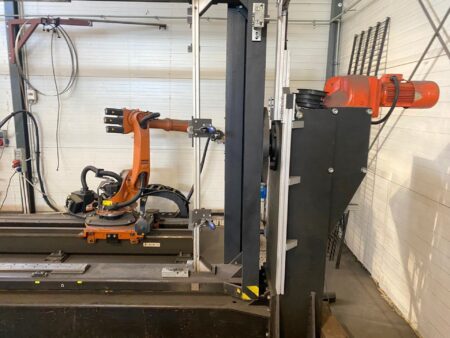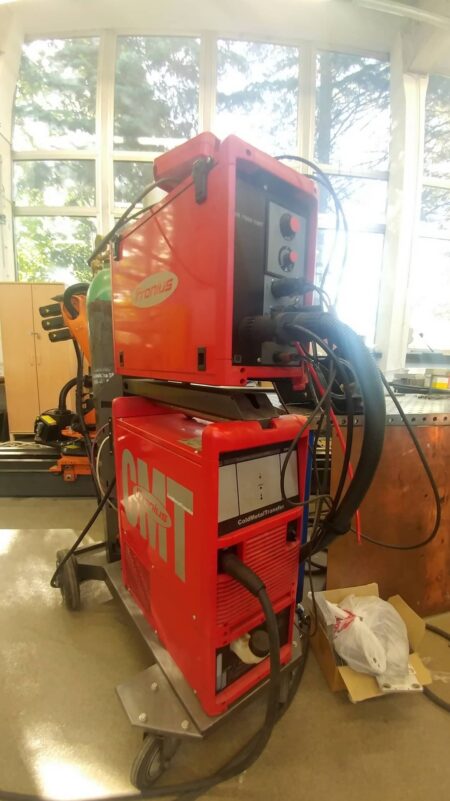KUKA KR16 L6 ARC-C robotic welding machine together with the PO-2t6m-01 rotary positioner was commissioned in 2017 and its purpose was to very precisely weld gates and fence spans, but it can also weld various types of structures that fit within the range of the rotary positioner. The welding station includes a robotic arm built in 2009, which was previously only used for testing. The whole thing has only worked for 50 hours.
The KUKA KR 16 L6 ARC-C robotic welding system is equipped with:
– welding robot: KUKA KR16 L6 ARC-C
– controller: KUKA KR C2
– rotary manipulator: PO-2t6m-01
– current power source: FRONIUS TransPuls Synergic 4000 CMT R
– software: KUKA System Software (KKS)
– torch cleaning device: TBi BRG-2-ES-DAE
– wire feeder: FRONIUS ROBACTA DRIVE CMT
– track
The rail-moving KUKA KR16 ARC industrial robot with a reach of 6 m allows excellent precision and superior weld quality to be achieved, even in hard-to-reach areas. All 6 axes of the machine are driven by an electromechanical system with brushless AC servomotors to guarantee the user excellent dynamics combined with process reliability. The robot is operated using a KUKA KR C2 controller with many useful functions, significantly increasing the productivity and efficiency of the machine.
During automated welding, dynamic and accurate feeding of the welding wire is very important. For this purpose, a FRONIUS ROBACTA DRIVE CMT feeder is placed directly on the welding torch body, which supports all machining processes and ensures precise feeding of the electrode wire. When the torch becomes contaminated, a special cleaning device TBi BRG-2-ES-DAE cuts off the wire tip, sprays the torch head in an enclosed spray chamber with anti-splinter fluid and removes the spatter through the rotating reamer.
In order to perform welded joints, the KUKA robotic welding station is equipped with a PO-2t6m-01 manipulator capable of rotating parts with a maximum weight of 2 tonnes and a length of 7 metres. The device consists of a coupler, a geared motor, a reaction arm, a control cabinet, a sensor mounting unit and two bodies made of welded sheet metal in which positioner shafts with bolted discs have been placed. Attached to the discs is a rotary table centred by means of pins inserted directly into holes in the positioned shafts.
Technical data of the KUKA KR16 L6 ARC-C robot
- number of axes: 6
- reach: 1911 mm
- maximum payload: 6 kg
- additional load on arm/ link arm/ rotating column: 10 kg/ variable/ 20 kg
- total distributed load: 36 kg
- axis movement range
- axis motion speed
- repeatability (ISO 9283): ± 0.1 mm
- mounting: floor, ceiling
- mounting flange: A6 DIN ISO 9490-1-A40
- work hours: 50 h
- weight of articulated robot KR16 L6 ARC-C: 250 kg
A1 axis: ± 114°
A2 axis: + 35° / -155°
A3 axis: + 154° / -130°
A4 axis: ± 350°
A5 axis: ± 130°
A6 axis: ± 350°
A1 axis: 156°/s
A2 axis: 156°/s
A3 axis: 156°/s
A4 axis: 335°/s
A5 axis: 335°/s
A6 axis: 647°/s
Technical specifications of rotary positioner PO-2t6m-01
- rotary table load capacity: 1040 kg
- total load capacity: 2000 kg
- distance between discs: 6350 mm
- base width: 960 mm
- axis position relative to the ground: 1407 mm
- axis position relative to the abutment: 1082 mm
- recommended number of anchors for fixing the positioner to the ground: 38 pcs.
- lifting shackle load capacity: 3,25 t
- ambient temperature of the control cabinet: 3-35 °C
- control cabinet power supply: 3x 400 V; 50 Hz
- overall dimensions (L x W x H): 7887 x 2000 x 2407 mm
- rotary table weight: 960 kg
- total weight: 3900 kg
- total weight including load capacity: 4940 kg

 Čeština
Čeština Français
Français Español
Español Deutsch
Deutsch polski
polski Русский
Русский Slovenčina
Slovenčina Magyar
Magyar Italiano
Italiano Türkçe
Türkçe
































